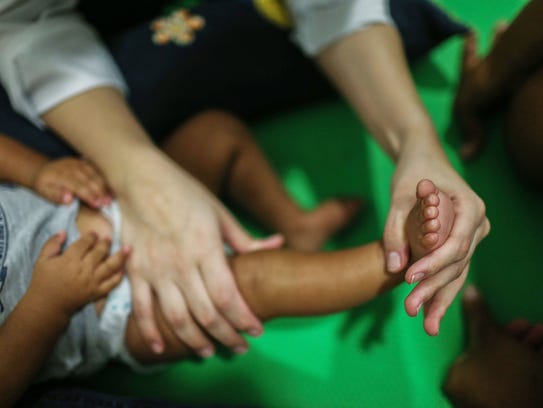 Liz Szabo, USA TODAY6:32 p.m. EDT August 8, 2016
Liz Szabo, USA TODAY6:32 p.m. EDT August 8, 2016
(Photo: Felipe Dana, AP)
A new study suggests that the damage done to babies by the Zika virus is even worse than previously known.
A Brazilian report published Tuesday links the Zika virus to a rare joint condition that can make it difficult or impossible for children to straighten their arms and legs.
Children with the condition, called arthrogryposis, have limited movement in joints such as the elbows or knees. In some cases, their joints are stuck in a one position and can't be unbent. The condition is not usually painful.
Zika is already known to cause a variety of birth defects, including blindness and microcephaly, in which babies are born with abnormally small heads and, in most cases, incomplete brain development.
Authors of the new study studied detailed brain and joint images of seven babies with the joint condition who are believed to have been infected with Zika while in the womb. All had brain calcifications, or lesions similar to scars that indicate past damage by a virus or other cause, according to the study, led by doctors in Recife, Brazil, the epicenter of that country's Zika epidemic.
Four of the babies' mothers had a rash — a common Zika symptom — while pregnant, according to the study, published in The BMJ, formerly The British Medical Journal.
Two babies tested positive for a past Zika infection; doctors didn't test the others, because the only test that can detect past infections isn't routinely available in Recife, according to the study.
All of the babies were born with dislocated hips, in which the femur has come out of the hip socket. Six of the children have microcephaly. Six had trouble swallowing; two needed feeding tubes, as well as tubes in their windpipes to help them breathe, the study said. All five boys in the study had testicles failed to descend from the abdomen to the scrotum.

Dr. Stella Guerra performs physical therapy on an infant born with microcephaly at Altino Ventura Foundation on June 2, 2016 in Recife, Brazil. (Photo: Mario Tama, Getty Images)
Most of the children had joint problems in both their arms and legs. Six of the babies had clubfoot, in which the foot is twisted so that the sole can't be placed on the ground. Six had fingers that were permanently bent. Five also had abnormalities in their eyes, according to the study.
Doctors tested six of the children's hearing. One had hearing problems in one ear, while a second had hearing problems in both ears.
Yet doctors found no abnormalities in the children's joints, according to the study. That suggests the children's conditions were caused by problems in nerve cells that carry signals to a fetus' muscles.
Treatment for arthrogryposis includes physical therapy to stretch and sterngthen muscles; occupational therapy to teach children skills such as dressing and feeding themselves; splints and casts to hold bones in place; and surgery to align bones or release a muscle or tendon that prevents a joint from moving well, according to Seattle Children's Hospital.
Some children with arthrogryposis do better than others. Kids who have a problem in only one joint can often be treated successfully, said James Bale, Jr., professor of pediatric neurology at the University of Utah School of Medicine, who was not involved in the new study.
Children with more severe arthrogryposis can also improve with therapy, but are often left with "lifelong disability," Bale said.
All babies with Zika infections should be examined for possible joint problems, authors said.
http://www.usatoday.com/story/news/2016/08/08/study-links-zika-virus-joint-problems-babies/88416832/
No comments:
Post a Comment